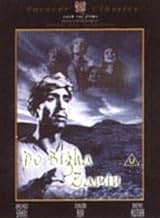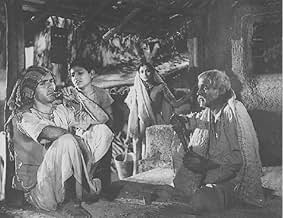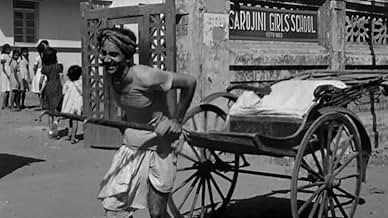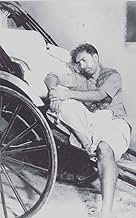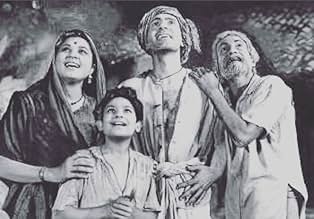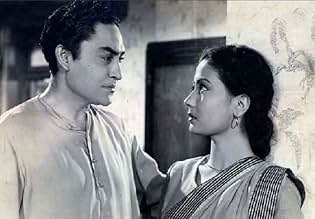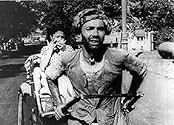Do Bigha Zamin
- 1953
- 2h 11min
CALIFICACIÓN DE IMDb
8.3/10
2.4 k
TU CALIFICACIÓN
Agrega una trama en tu idiomaIn the hope of earning enough money to pay off his debts and save his land, a poor farmer becomes a rickshaw puller in Calcutta and faces many difficulties.In the hope of earning enough money to pay off his debts and save his land, a poor farmer becomes a rickshaw puller in Calcutta and faces many difficulties.In the hope of earning enough money to pay off his debts and save his land, a poor farmer becomes a rickshaw puller in Calcutta and faces many difficulties.
- Dirección
- Guionistas
- Elenco
- Premios
- 4 premios ganados y 2 nominaciones en total
Ratan Kumar
- Kanhaiya Maheto
- (as Rattan Kumar)
Rajlakshmi Devi
- Nayabji
- (as Rajlakshmi)
Nasir Hussain
- Rickshaw puller
- (as Nazir Hussain)
Ramayan Tiwari
- Paro's molester
- (as Tiwari)
- Dirección
- Guionistas
- Todo el elenco y el equipo
- Producción, taquilla y más en IMDbPro
Opiniones destacadas
Post world war II, cinema was deeply influenced by the Italian realist wave. Rosselini and Visconti's hard hitting social commentary and De Sica's day-to-day struggle changed film-making like never before (or since). This wave gave birth to directors like Kurosawa, Fellini and Ray. One of the Indian masterpieces of those days was Bimal Roy's Do Bigha Zamin, which can arguably be termed as the Indian answer to De Sica's The Bicycle Thief.
This film has it's heart in the right place. The indivisible nature of the family, all of whose members work towards the fulfillment of a single objective, which is the fabric of Indian society, is the beauty of the film. All of the members- Shambhu, his wife, his father and son, intend to alleviate his situation and try to contribute in every way possible. The film ends in a sad satirical note, which is the principle characteristic of neo-realistic cinema.
Story apart, the most beautiful aspect of the film is the spirit with which on upholding of one's dignity and self esteem in the most perturbing situations. Though, the protagonist, Shambhu could have executed his task easily many ways, he opts for the most ethical choice of all- hard work. It is quite evident that Do Bhiga Zamin has been influenced by (and has influenced) cinema spanning different geographical, linguistic, and social backgrounds, but it still has a firm foot in its culture.
This film has it's heart in the right place. The indivisible nature of the family, all of whose members work towards the fulfillment of a single objective, which is the fabric of Indian society, is the beauty of the film. All of the members- Shambhu, his wife, his father and son, intend to alleviate his situation and try to contribute in every way possible. The film ends in a sad satirical note, which is the principle characteristic of neo-realistic cinema.
Story apart, the most beautiful aspect of the film is the spirit with which on upholding of one's dignity and self esteem in the most perturbing situations. Though, the protagonist, Shambhu could have executed his task easily many ways, he opts for the most ethical choice of all- hard work. It is quite evident that Do Bhiga Zamin has been influenced by (and has influenced) cinema spanning different geographical, linguistic, and social backgrounds, but it still has a firm foot in its culture.
This movie is a an Indian classic.... I don't know why so many people here are going on about how unrealistic it is...... I would wonder how many who commented as such have actually been to that part of India and witnessed the poverty there....
The story may well have been copied but the film is no doubt still great. I cant think of many other copies which are actually good. This film does actually touch you with its sadness, and claims of melodramaticness will be gladly tossed aside because we are talking about Indian cinema here...
All in all i think this is definitely a gem in Indian cinema, and fit the bill of an all time classic.
The story may well have been copied but the film is no doubt still great. I cant think of many other copies which are actually good. This film does actually touch you with its sadness, and claims of melodramaticness will be gladly tossed aside because we are talking about Indian cinema here...
All in all i think this is definitely a gem in Indian cinema, and fit the bill of an all time classic.
I have seen Do Bigha Zamin many times ( at least five ) but never had a chance to write a review. Every time I see this movie I put my hats off to Mr. Bimal Roy as the director of this masterpiece. I have read comments about having the idea from a different film ( Vittorio Di Sica's Bicycle Thief ) But I can challenge a lot of director to copy any film they want and produce something like Do Bigha Zamin. The scenes of a village in Bengal and the streets of Calcutta ( now Kolkata ) in early fifties are so real - it just sends shivers through my body. I was a student in a Calcutta college during that period and the scenes from Esplanade area, with Metro Cinema, Chowringhee Road, the double decker buses, the trams and finally the human rickshaws were presented in such a way that I felt being there in that period. The poverty of the villagers and as well as the bustee dwellers were very realistic and the characters were portrayed and played extremely well. Some of the scenes like when Paro went to Meena Kumari to get a letter written, the short scene where Nirupa Roy complaining to Balraj Sahni that he does not love her are very touching scenes. One of the other wonders are the boot polish kid Laloo. I don,t know whether he is an actor or real boot polish kid in real life , but he displayed a wonderful piece of acting as the friendly companion to Kanhaiya ( Rattan Kumar ). Nirupa Roy as the wife of the peasant Balraj Sahani, Balraj Sahani himself and Rattan Kunmar all played their parts very well. I should also mention the role played by Rajlakhsmi Devi as the Bustee owner - what can be more realistic than that. Though the economic scene in India has changed over the last sixty years still there are a lot of poverty in India and peasants like Shambhu Mahato can be found all over India. I appreciate the director's last scene where it shows the family is still intact with hope for the future at the same time the struggle for survival goes on as they lost their land to the greedy landlord. I have the DVD and will watch it many more times.
After watching the Satyajit Ray films, The Apu Trilogy (1955-1959) and Devi (1960), I decided to check out some of the realistic films directed by other Bengali filmmakers during that same era. One of the films I found was Do Bigha Zamin, which won the International Prize at the 1954 Cannes Film Festival.
Although it's a Hindi-language film, and therefore technically a 'Bollywood' movie, the film's director Bimal Roy is from Bengal, thus the film has more in common with Bengali art cinema than it does with mainstream Bollywood as a result. The film does have a few musical numbers, like a lot of other Hollywood and Bollywood movies of that era, but what sets Do Bigha Zamin apart is its greater sense of realism. Beyond the few musical numbers, the film itself doesn't have much melodrama to it and there isn't much of a background score either, which is a good thing to me as a sappy or sentimental score isn't necessary for a film like this.
Do Bigha Zamin is very much a character-driven drama and the actors did a great job in portraying their respective characters. The performances which stand out most are Balraj Sahni as the farmer Shambu, the protagonist of the story, and the child actor Rattan Kumar as his son Kanhaiya. Nirupa Roy also gave a very good performance as Shambu's wife Paro.
As for Bimal Roy's direction, the film has one of the best depictions of poverty I've ever seen, covering both rural poverty in a Bengali village and urban poverty in Calcutta (now Kolkata), including the plight of street kids living in the city's slums. The film's ending was also powerful and it was overall a very moving film.
8/10
Although it's a Hindi-language film, and therefore technically a 'Bollywood' movie, the film's director Bimal Roy is from Bengal, thus the film has more in common with Bengali art cinema than it does with mainstream Bollywood as a result. The film does have a few musical numbers, like a lot of other Hollywood and Bollywood movies of that era, but what sets Do Bigha Zamin apart is its greater sense of realism. Beyond the few musical numbers, the film itself doesn't have much melodrama to it and there isn't much of a background score either, which is a good thing to me as a sappy or sentimental score isn't necessary for a film like this.
Do Bigha Zamin is very much a character-driven drama and the actors did a great job in portraying their respective characters. The performances which stand out most are Balraj Sahni as the farmer Shambu, the protagonist of the story, and the child actor Rattan Kumar as his son Kanhaiya. Nirupa Roy also gave a very good performance as Shambu's wife Paro.
As for Bimal Roy's direction, the film has one of the best depictions of poverty I've ever seen, covering both rural poverty in a Bengali village and urban poverty in Calcutta (now Kolkata), including the plight of street kids living in the city's slums. The film's ending was also powerful and it was overall a very moving film.
8/10
Made in 1953, with a socialist theme that was typical of many great bengali directors, this was a great film with superlative performances and very real feel to the film. Balraj Sahni, one of the five greatest actors of India ever, was simply stunning in this movie in terms of his natural acting and superior understanding of the life of a peasant first and then a novice rickshaw (two wheel cart pulled by a human, instead of the horse) puller fresh in the city (He naturally doesn't know that once u take a passenger to the destination, u have to hold it down so that the passenger can alight - he nervously waits for his first dime)..Ill have to come back and write more..sorry
¿Sabías que…?
- TriviaWhen the shoeshine boys discuss seeing Nargis in El vagabundo (1951), one of them alludes to a shirt worn by a bystander. The shirt is decorated with a recurring pattern showing the famous scene from El vagabundo (1951) in which Raj Kapoor comes upon Nargis as she is changing clothes, partially hidden by a screen, after swimming. That scene occupies a place in Hindi cinema comparable to that of Deborah Kerr and Burt Lancaster on the beach in De aquí a la eternidad (1953).
- ConexionesFeatured in Century of Cinema: And the Show Goes On: Indian Chapter (1996)
- Bandas sonorashariyaala saawan dhol bajaata aaya
Sung by Lata Mangeshkar, Manna Dey
Selecciones populares
Inicia sesión para calificar y agrega a la lista de videos para obtener recomendaciones personalizadas
2025 Venice Film Festival Guide
2025 Venice Film Festival Guide
See the full lineup for the 2025 Venice Film Festival, taking place Aug. 27 – Sept. 9, 2025.
- How long is Do Bigha Zamin?Con tecnología de Alexa
Detalles
- Tiempo de ejecución
- 2h 11min(131 min)
- Color
- Relación de aspecto
- 1.37 : 1
Contribuir a esta página
Sugiere una edición o agrega el contenido que falta


